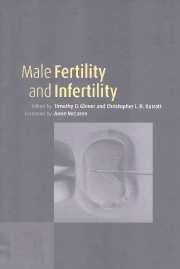Book contents
- Frontmatter
- Contents
- List of contributors
- Foreword by Anne McLaren, FRS
- Preface
- Acknowledgements
- Part 1 Biological perspectives
- 1 The evolution of the sexual arena
- 2 The role of sperm competition in reproduction
- 3 Sperm production and delivery in mammals, including man
- 4 The local control of spermatogenesis
- 5 Some misconceptions of the human epididymis
- 6 Transport of spermatozoa to the egg and fertilization success
- 7 Changes in human male reproductive health
- Part 2 Implications of the new technologies
- Index
1 - The evolution of the sexual arena
from Part 1 - Biological perspectives
Published online by Cambridge University Press: 09 August 2009
- Frontmatter
- Contents
- List of contributors
- Foreword by Anne McLaren, FRS
- Preface
- Acknowledgements
- Part 1 Biological perspectives
- 1 The evolution of the sexual arena
- 2 The role of sperm competition in reproduction
- 3 Sperm production and delivery in mammals, including man
- 4 The local control of spermatogenesis
- 5 Some misconceptions of the human epididymis
- 6 Transport of spermatozoa to the egg and fertilization success
- 7 Changes in human male reproductive health
- Part 2 Implications of the new technologies
- Index
Summary
Introduction: the Scala Naturae of reproduction
In the early 1950s, a Scala Naturae view of the evolution of sex was fashionable and alas it still survives in some quarters 40 years on. The Scala Naturae embodied a ladder of ‘improvements’ in our evolution, exemplified by a succession of modern species. Its peak of reproductive sophistication was seen as being a man and a woman. Primitive asexual creatures such as bacteria, plants and coelenterates, which simply bud or divide into two, provided the first steps of the ladder. An excess of cell division leads to their multiplication, thereby providing safety in numbers.
The next steps on the Scala constituted protection of the reproductive products, spores and seeds. Dormancy is the reproductive tactic, especially among primitive bacteria, fungi and even plants such as angiosperms. Viviparity was seen as showing the ‘highest’ form of care and protection and its peak was achieved in mammals, although a few other species also show this form of reproduction.
However, diversity was seen to be a ‘Good Thing’, partly because it dealt with variable or patchy environmental conditions, partly because nature was varied in time and space and needed to be kept track of. So mutations suddenly became useful on the evolutionary scene. Before this point they could simply be considered as ‘useless’ mistakes in genome replication, which primitive creatures could not avoid. However, they landed simple asexual creatures into Muller's ratchet trouble if you were a clone (Morell, 1997).
- Type
- Chapter
- Information
- Male Fertility and Infertility , pp. 3 - 17Publisher: Cambridge University PressPrint publication year: 1999



